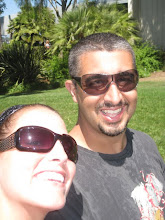Monday, March 1, 2010
Welcome
I'm writing this blog about my husband, Matt, and his struggle with polycystic kidney disease. I'm going to try to fill in information about the disease itself, as well as give information to friends, family and acquaintances who would like to stay updated with his situation.
Even though it is now March, Matt's kidney issues started getting bad this past summer, 2009.
Matt will be 33 this May. He was first diagnosed with PKD when he was about 23. His mother, and other family members also had the disease. MaryAnn, Matt's mother, just passed away this past December after a long fight with PKD. The following information about PKD is from http://www.pkdcure.org/:
Polycystic Kidney Disease is the most common genetic, life threatening disease affecting more than 600,000 Americans and an estimated 12.5 million people worldwide - regardless of sex, age, race or ethnic origin. In fact, PKD affects more people than cystic fibrosis, muscular dystrophy, hemophilia, Down syndrome and sickle cell anemia — combined.
Polycystic means multiple cysts. In effect, PKD denotes multiple cysts on each kidney. These cysts grow and multiply over time, also causing the mass of the kidney to increase. Ultimately, the diseased kidney shuts down causing end-stage renal disease for which dialysis and transplantation are the only forms of treatment.
PKD comes in two forms. Autosomal Dominant Polycystic Kidney Disease (ADPKD) is the most common, affecting 1-in-400 to 1-in-500 adults. Autosomal Recessive Polycystic Kidney Disease (ARPKD) is far less common, affecting 1-in-10,000 at a far younger age, including newborns, infants and children.
Matt was diagnosed with the autosomal dominant variety of PKD. That means that there is a fifty percent chance of passing the disease on to each of our kids, Vince and Andre. Once Matt learned he had the disease, he started seeing his nephrologist (kidney doctor) on a regular basis. They did regular blood checks and monitored him over the past 10 years.
The most common problem for kidney disease patients is high blood pressure. Matt has been on blood pressure medication for a long time. He has also has frequent attacks of gout, where his foot just cramps up causing tremendous pain. The doctor checks his creatinine levels in his blood. A normal person's creatinine level is around 1.0. Matt's is now about 4.8. As your kidney function decreases, your creatinine level increases. When your kidney function goes below 20% you start the process of transplantation. If your function drops below 10%, you need to begin dialysis. Matt's kidney function is about 15% right now. So we are beginning the process of getting Matt a new kidney.
Subscribe to:
Post Comments (Atom)

You did an unbelievable job on the post Jackie! There were things you touched on that I was completely clueless on regarding the disease. I just want to say that I will be a regular reader of the blog and will do anything I can to help if you need it. Matt must know he has a LOT of people behind him.
ReplyDeleteKibs & Family
Way to go Jaclyn! This is a great way to keep everyone informed. I'm assuming you'll be putting up info on how people can find out if they are a possible match, so let's find a kidney ;)
ReplyDeleteLove you guys,
Melissa, Damon and Avery
Jackie,
ReplyDeleteWhat a great thing to do...and your descriptions of the disease are clear and understandable. As you know I am very familiar with PKD and will keep you and your family in my prayers as you journey through the transplant process. About 15-20 people in my family do the PKD walk in Boston. It is usually in September...maybe we can round up a team of Matt's friends to participate. Research makes all the difference. I'm sure Matt sees the differences in approach in treatment from when Mary Ann was first diagnosed to now...Blessings to all, Nancy Dome
Jackie -
ReplyDeleteThis is a terrific, informative post. I hope you and your friends and family will be able to participate in the Boston PKD Walk on September 25th, 2010 in Artesani Park. Not only is the Walk an opportunity to make a significant contribution to advancing research to find a cure for this disease, but it is an event where people such as yourself can find great comfort and support in the company of others who are affected by PKD. More information about the walk can be found at www.pkdcure.org (The website of the PKD FOundation) and also www.bostonpkdwalk.org, a blog which we've recently created to bring the New England PKD community closer together in support of the walk and in support of each other.
Good luck, and stay positive! We'll find a cure.
Jackie- I was glad to find this blog through the Boston Walk for PKD blog. Thanks for attending the tplant workshop on Saturday. I hope you found it beneficial. I would love to hear your thoughts on it. Feel free to email me at the chapter - newenglandchapter@pkdcure.org.
ReplyDeleteI second what one of your previous comments said about the benefits of setting up a team and walking to raise critical research funding. And it is very therapeutic! Best Regards, Judy Ehrlich
Hi Jackie & Matt, We are going through the same thing too. The most important thing for Matt right now is to follow strictly the low potassium, low sodium, low protein diet. No bananas, oranges(or juice), potatoes, and tomatoes. We have been quite sucessful in lowering my husband's potassium and sodium thus far. It's a big change, but I'm following it with him too. Hang in there!
ReplyDelete